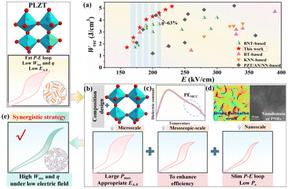Synergistic strategy of composition design and multiscale structure regulation for high energy storage performance of PLZT under low electric fields
IF 9.5
2区 材料科学
Q1 CHEMISTRY, PHYSICAL
引用次数: 0
Abstract
Dielectric energy storage ceramics have become the core driving force for the development of high-tech fields. However, the high energy storage density usually requires high electric field excitation; this not only increases the energy consumption of electric power resources but also raises the risk of device failure. Furthermore, it is often difficult to achieve a balance between recoverable energy density (Wrec) and efficiency (η). Therefore, developing high energy storage performance materials under low electric fields is a bottleneck issue. In this study, relaxor antiferroelectric ceramics of Pb0.9325-xLa0.045CaxZr0.92Ti0.075Hf0.005O3 (PLCxZTH) were designed by a synergistic optimization strategy of composition design and multi-scale structure manipulation. Then, a high Wrec (∼5.15 J cm−3) and η (∼85.1%) under 230 kV cm−1 were realized in PLC0.03ZTH. Even when the working electric field was reduced to 190 kV cm−1, the Wrec could still reach 4.05 J cm−3 with high η of 87.1%. The energy storage performance is superior to that of other works. Multi-level structure characterization suggests that the enhanced stability of the orthorhombic phase strengthens the antiferroelectricity and Pmax, and the PEMCC phase elicited by compositional inhomogeneity can reduce the hysteresis loss to optimize η. Most importantly, the induced strong localized fluctuations of strain at the nanoscale alter the energy barrier distribution, promoting the formation of nano-domain structure and polar nanoregions (PNRs), which significantly increased Wrec and η under low electric fields. These results represent a breakthrough in balancing the reduced working electric field and energy storage density as well as efficiency. The study proposes a novel paradigm for designing high energy storage performance ceramics under low electric fields, holding critical significance for next-generation pulse power systems and compact electronics.

低电场下PLZT高储能性能的组合设计与多尺度结构调控协同策略
介质储能陶瓷已成为高新技术领域发展的核心动力。然而,高储能密度通常需要高电场激励;这不仅增加了电力资源的能耗,也增加了设备故障的风险。此外,通常很难在可采能量密度(Wrec)和效率(η)之间取得平衡。因此,开发低电场下的高储能性能材料是一个瓶颈问题。本研究采用成分设计和多尺度结构操纵协同优化策略,设计了pb0.9325 - xla0.045 caxzr0.92 ti0.075 hf0.0050 o3 (PLCxZTH)弛缓反铁电陶瓷。然后,在PLC0.03ZTH中实现了230 kV cm−1下的高Wrec (~ 5.15 J cm−3)和η(~ 85.1%)。当工作电场降至190 kV cm−1时,η值仍可达4.05 J cm−3,η值高达87.1%。储能性能优于其他同类产品。多层结构表征表明,正交相的稳定性增强增强了反铁电性和Pmax,而成分不均匀性引起的PEMCC相可以减少磁滞损失以优化η。最重要的是,在低电场条件下,在纳米尺度上引起的强局域应变波动改变了能垒分布,促进了纳米畴结构和极性纳米区(PNRs)的形成,显著增加了wrc和η。这些结果在平衡减小的工作电场和能量存储密度以及效率方面取得了突破。该研究为设计低电场下高能量存储性能陶瓷提供了一种新的范例,对下一代脉冲电源系统和紧凑型电子产品具有重要意义。
本文章由计算机程序翻译,如有差异,请以英文原文为准。
求助全文
约1分钟内获得全文
求助全文
来源期刊

Journal of Materials Chemistry A
CHEMISTRY, PHYSICAL-ENERGY & FUELS
CiteScore
19.50
自引率
5.00%
发文量
1892
审稿时长
1.5 months
期刊介绍:
The Journal of Materials Chemistry A, B & C covers a wide range of high-quality studies in the field of materials chemistry, with each section focusing on specific applications of the materials studied. Journal of Materials Chemistry A emphasizes applications in energy and sustainability, including topics such as artificial photosynthesis, batteries, and fuel cells. Journal of Materials Chemistry B focuses on applications in biology and medicine, while Journal of Materials Chemistry C covers applications in optical, magnetic, and electronic devices. Example topic areas within the scope of Journal of Materials Chemistry A include catalysis, green/sustainable materials, sensors, and water treatment, among others.
 求助内容:
求助内容: 应助结果提醒方式:
应助结果提醒方式:


